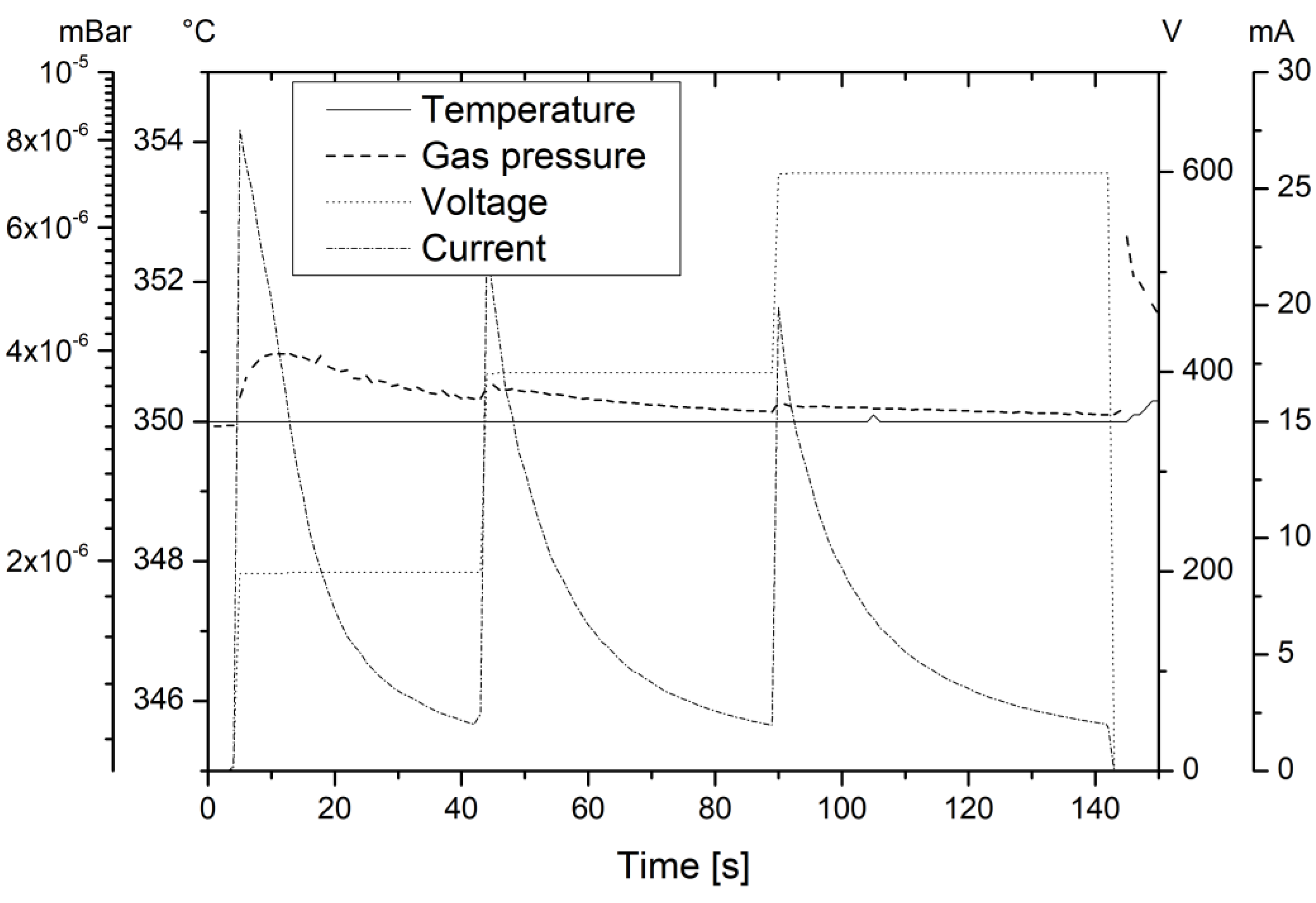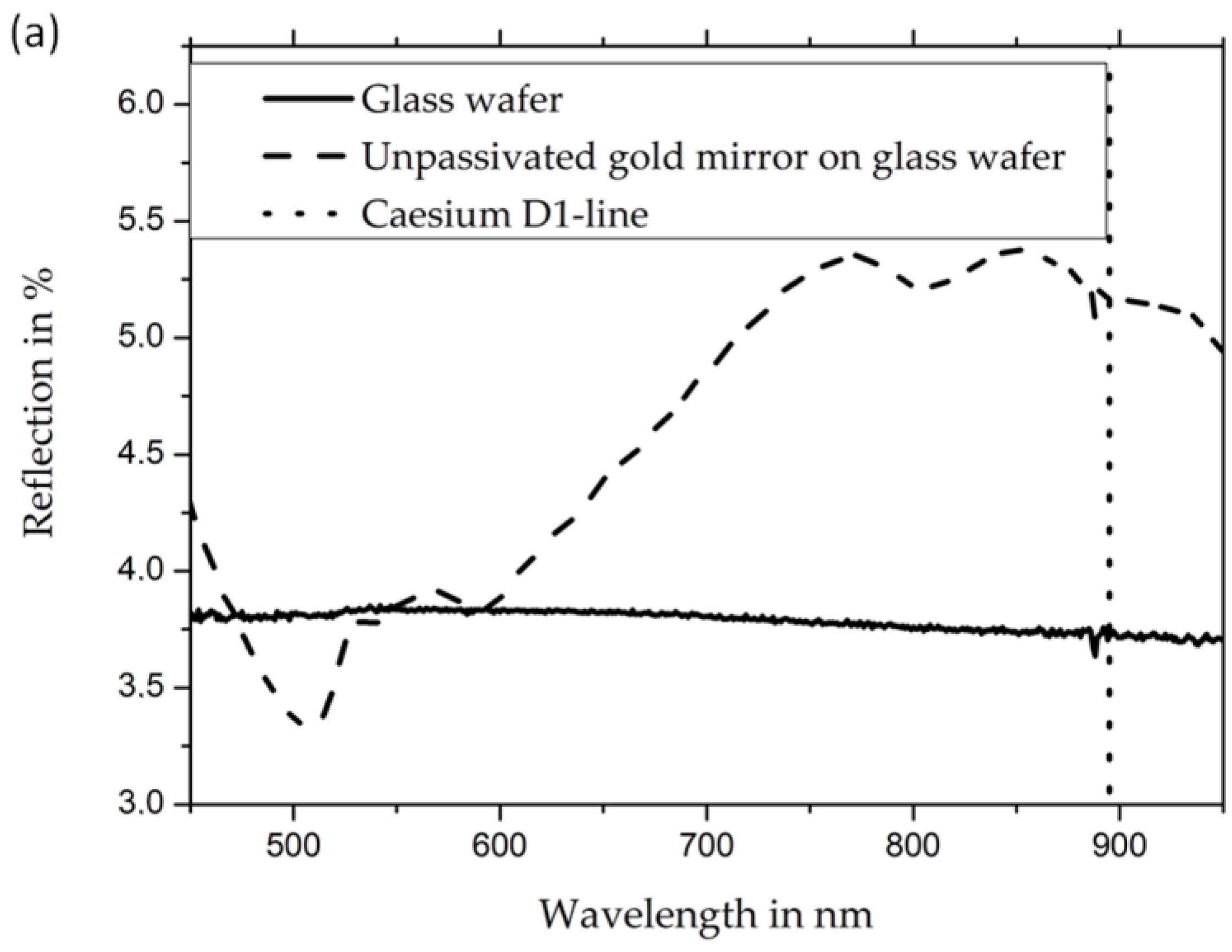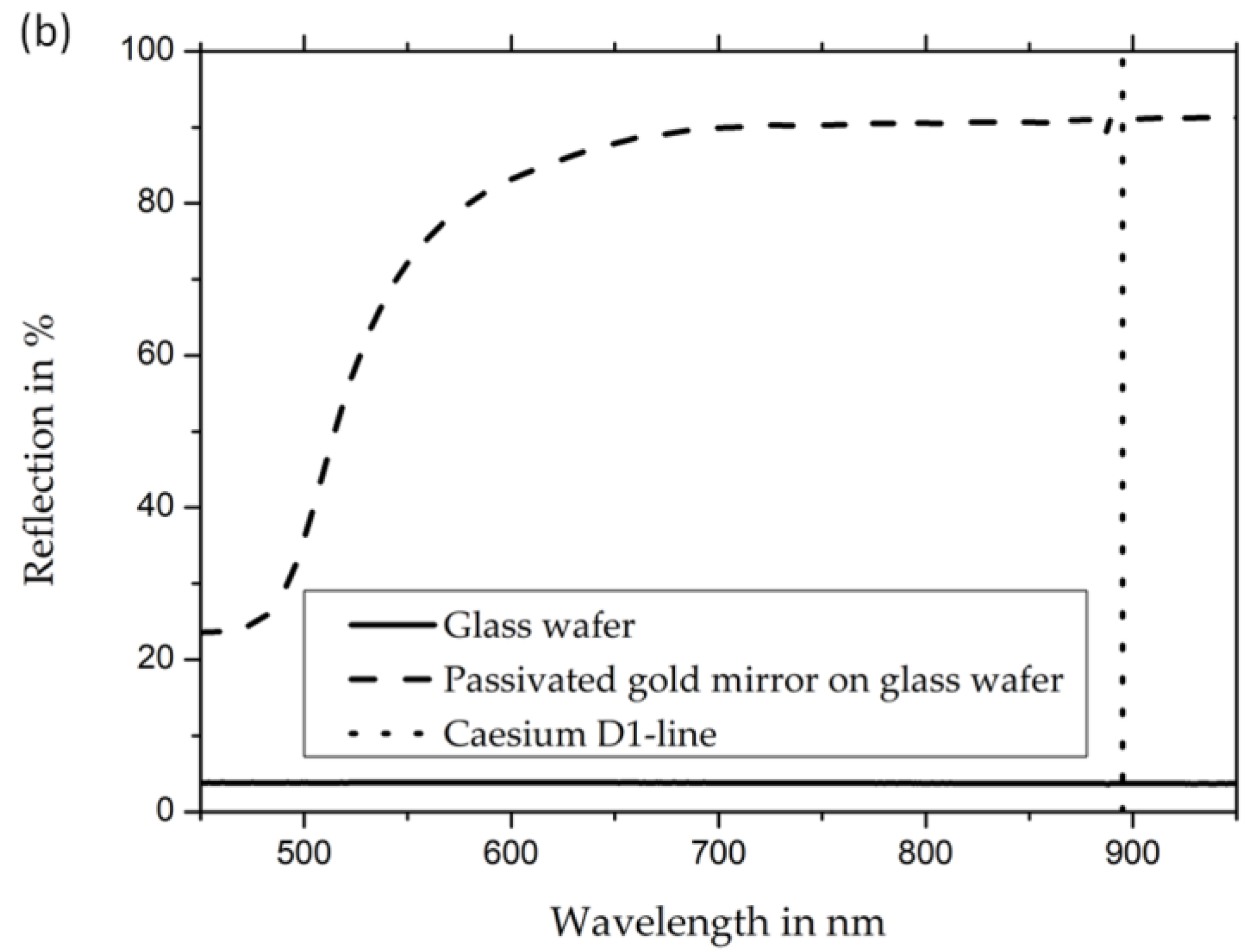Integration of Passivated Gold Mirrors into Microfabricated Alkali Vapor Cells
Abstract
:1. Introduction
2. Materials and Methods
3. Results
4. Discussion
5. Conclusions and Outlook
Author Contributions
Funding
Institutional Review Board Statement
Informed Consent Statement
Data Availability Statement
Acknowledgments
Conflicts of Interest
References
- Budker, D.; Jackson, K.; Derek, F. Optical Magnetometry, 1st ed.; Cambridge University Press: Cambridge, UK, 2013; p. 3. [Google Scholar]
- Liew, L.-A.; Knappe, S.; Moreland, J.; Robinson, H.; Hollberg, L.; Kitching, J. Microfabricated alkali atom vapor cells. Appl. Phys. Lett. 2004, 84, 2694–2696. [Google Scholar] [CrossRef]
- Karlen, S.; Overstolz, T.; Gobet, J.; Haesler, J.; Droz, F.; Lecomte, S. Gold microdiscs as alkali preferential condensation spots for cell clock long-term frequency improvement. In Proceedings of the 2018 European Frequency and Time Forum (EFTF), Turin, Italy, 10–12 April 2018; pp. 91–93. [Google Scholar] [CrossRef]
- Han, R.; You, Z.; Zhang, F.; Xue, H.; Ruan, Y. Microfabricated Vapor Cells with Reflective Sidewalls for Chip Scale Atomic Sensors. Micromachines 2018, 9, 175. [Google Scholar] [CrossRef] [PubMed]
- Kitching, J.; Donley, E.A.; Hodby, E.; Shkel, A.; Eklund, J. Compact Atomic Magnetometer and Gyroscope Based on a Diverging Laser Beam. U.S. Patent 7,872,473 B2, 12 February 2009. [Google Scholar]
- Chutani, R.; Maurice, V.; Passilly, N.; Gorecki, C.; Boudot, R.; Hafiz, M.A.; Abbé, P.; Galliou, S.; Rauch, J.-Y.; de Clercq, E. Laser light routing in an elongated micromachined vapor cell with diffraction gratings for atomic clock applications. Sci. Rep. 2015, 5, 14001. [Google Scholar] [CrossRef] [PubMed]
- Nishino, H.; Toda, M.; Yano, Y.; Kajita, M.; Ido, T.; Hara, M.; Ono, T. A Reflection Type Vapor Cell Based on Local Anodic Bonding of 45° Mirrors for Micro Atomic Clocks. In Proceedings of the 2019 20th International Conference on Solid-State Sensors, Actuators and Microsystems & Eurosensors XXXIII (TRANSDUCERS & EUROSENSORS XXXIII), Berlin, Germany, 23–27 June 2019; pp. 1530–1532. [Google Scholar] [CrossRef]
- Perez, M.; Nguyen, U.; Knappe, S.; Donley, E.A.; Kitching, J.; Shkel, A.M. Rubidium vapor cell with integrated Bragg reflectors for compact atomic MEMS. Sens. Actuator A-Phys. 2009, 154, 295–303. [Google Scholar] [CrossRef]
- Li, S.; Vachaspati, P.; Sheng, D.; Dural, N.; Romalis, M.V. Optical rotation in excess of 100 rad generated by Rb vapor in a multipass cell. Phys. Rev. A 2011, 84, 061403. [Google Scholar] [CrossRef]
- Nix, F.C.; MacNair, D. The Thermal Expansion of Pure Metals: Copper, Gold, Aluminum, Nickel, and Iron. Phys. Rev. 1941, 60, 597. [Google Scholar] [CrossRef]
- Kienast, G.; Verma, J.; Klemm, W. Das Verhalten der Alkalimetalle zu Kupfer, Silber und Gold. Z. Anorg. Allg. Chem. 1961, 310, 143–169. [Google Scholar] [CrossRef]
- Busse, B.; Weil, K.G. Existenz und Bindungsenergie des Caesiumaurid-Moleküls. Angew. Chem. 1979, 91, 664–665. [Google Scholar] [CrossRef]
- Hirashima, M.; Asano, M. Effects of Caesium Vapour upon Target Glass of Image Orthicon. Adv. Electron. Electron Phys. 1966, 22, 651–660. [Google Scholar] [CrossRef]
- Woetzel, S.; Schultze, V.; IJsselsteijn, R.; Schulz, T.; Anders, S.; Stolz, R.; Meyer, H.-G. Microfabricated atomic vapor cell arrays for magnetic field measurements. Rev. Sci. Instrum. 2011, 82, 033111. [Google Scholar] [CrossRef] [PubMed]
- Woetzel, S.; Talkenberg, F.; Scholtes, T.; Ijsselsteijn, R.; Schultze, V.; Meyer, H.-G. Lifetime improvement of micro-fabricated alkali vapor cells by atomic layer deposited wall coatings. Surf. Coatings Technol. 2013, 221, 158–162. [Google Scholar] [CrossRef]
- Karlen, S.; Gobet, J.; Overstolz, T.; Haesler, J.; Lecomte, S. Lifetime assessment of RbN3-filled MEMS atomic vapor cells with Al2O3 coating. Opt. Express 2017, 25, 2187–2194. [Google Scholar] [CrossRef] [PubMed]
- Dziuban, J.A. Bonding in Microsystem Technology, 1st ed.; Springer: Amsterdam, The Netherlands, 2006; p. 170. [Google Scholar]
- EVG®501 Wafer Bonding System. Available online: https://www.evgroup.com/products/bonding/permanent-bonding-systems/evg501 (accessed on 19 September 2023).
- Olympus. Available online: https://www.olympus-ims.com/en/ (accessed on 19 September 2023).
- Borofloat Technische Daten. Available online: https://www.schott.com/de-de/products/borofloat-p1000314/technical-details?tab=51295d4ebc7045a1850d9f38114ec9b8 (accessed on 29 August 2023).
- Campbell, W.J.; Grain, C. Thermal expansion of alpha-alumina. Adv. X-ray Anal. 1961, 5, 244–256. [Google Scholar] [CrossRef]
- Schultze, V.; Schillig, B.; IJsselsteijn, R.; Scholtes, T.; Woetzel, S.; Stolz, R. An Optically Pumped Magnetometer Working in the Light-Shift Dispersed Mz Mode. Sensors 2017, 17, 561. [Google Scholar] [CrossRef] [PubMed]







Disclaimer/Publisher’s Note: The statements, opinions and data contained in all publications are solely those of the individual author(s) and contributor(s) and not of MDPI and/or the editor(s). MDPI and/or the editor(s) disclaim responsibility for any injury to people or property resulting from any ideas, methods, instructions or products referred to in the content. |
© 2023 by the authors. Licensee MDPI, Basel, Switzerland. This article is an open access article distributed under the terms and conditions of the Creative Commons Attribution (CC BY) license (https://creativecommons.org/licenses/by/4.0/).
Share and Cite
Wittkämper, F.; Scholtes, T.; Linzen, S.; Ziegler, M.; Stolz, R. Integration of Passivated Gold Mirrors into Microfabricated Alkali Vapor Cells. Coatings 2023, 13, 1733. https://doi.org/10.3390/coatings13101733
Wittkämper F, Scholtes T, Linzen S, Ziegler M, Stolz R. Integration of Passivated Gold Mirrors into Microfabricated Alkali Vapor Cells. Coatings. 2023; 13(10):1733. https://doi.org/10.3390/coatings13101733
Chicago/Turabian StyleWittkämper, Florian, Theo Scholtes, Sven Linzen, Mario Ziegler, and Ronny Stolz. 2023. "Integration of Passivated Gold Mirrors into Microfabricated Alkali Vapor Cells" Coatings 13, no. 10: 1733. https://doi.org/10.3390/coatings13101733
APA StyleWittkämper, F., Scholtes, T., Linzen, S., Ziegler, M., & Stolz, R. (2023). Integration of Passivated Gold Mirrors into Microfabricated Alkali Vapor Cells. Coatings, 13(10), 1733. https://doi.org/10.3390/coatings13101733








